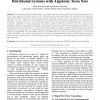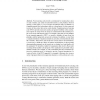43 search results - page 8 / 9 » Secure or insure |
IHI
2010
13 years 4 months ago
2010
Regulations in various countries permit the reuse of health information without patient authorization provided the data is "de-identified". In the United States, for ins...
IAJIT
2010
13 years 8 months ago
2010
: The specification of the dynamic behaviour of reactive distributed systems must exhibit the structures of control and has to imply explicitly the relevant aspects of the distribu...
VLDB
2001
ACM
14 years 9 months ago
2001
ACM
Smartcards are the most secure portable computing device today. They have been used successfully in applications involving money, proprietary and personal data (such as banking, h...
RTA
2005
Springer
14 years 2 months ago
2005
Springer
Proof-carrying code provides a mechanism for insuring that a host, or code consumer, can safely run code delivered by a code producer. The host specifies a safety policy as a set ...
FUIN
2007
13 years 9 months ago
2007
Proof-carryingcode provides a mechanism for insuring that a host, or code consumer, can safely run code delivered by a code producer. The host specifies a safety policy as a set o...


